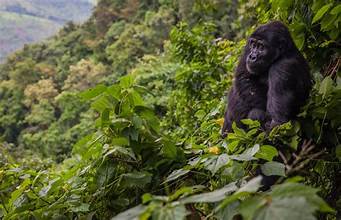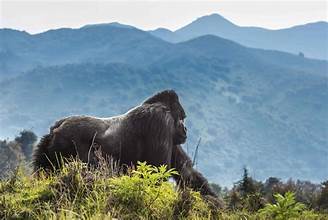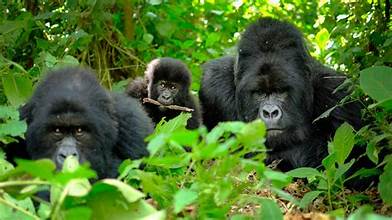If you’ve ever seen a gorilla in a zoo, chances are it wasn’t a mountain gorilla. Mountain gorillas are unique in that they cannot survive in captivity, making them among the few species you can only witness in their natural habitat. This fact alone makes the opportunity to see them in the wild even more special and worth the journey.
Mountain gorillas inhabit the stunning highlands of Uganda, Rwanda, and the Democratic Republic of Congo (DRC). These primates are oblivious to borders, often wandering between these countries. Unfortunately, in the 1980s, the mountain gorilla population faced the brink of extinction, with only 254 individuals remaining. Thankfully, through intense conservation efforts and regulated eco-tourism, their numbers have grown, and their status has shifted from critically endangered to endangered. Today, more than 1,000 mountain gorillas roam the forests, and seeing them in the wild is now one of the most cherished wildlife experiences on the planet.
If you are planning a trip to witness these majestic creatures, here’s a guide on where you can see them and what to expect.
Bwindi Impenetrable National Park, Uganda
Located in southwestern Uganda, Bwindi Impenetrable National Park is home to over half of the world’s remaining mountain gorilla population. With approximately 500 individuals, Bwindi offers one of the most intimate and awe-inspiring gorilla trekking experiences in the world. The park is a dense, lush rainforest, brimming with biodiversity and towering trees, making the trek an adventure in itself.
Gorilla trekking in Bwindi involves hiking through thick vegetation, crossing streams, and climbing steep hills until you reach a habituated gorilla family. Habituation is the process of gradually accustoming gorilla groups to human presence, allowing visitors to observe them without disrupting their natural behaviors. Encountering a gorilla family is a life-changing experience—you’ll witness mothers caring for their young, dominant silverbacks standing guard, and juveniles playing in the canopy.

Mgahinga Gorilla National Park, Uganda
Also situated in southwestern Uganda, Mgahinga Gorilla National Park is part of the greater Virunga Massif, which spans Rwanda and the DRC. Though smaller than Bwindi, Mgahinga covers just 37 square kilometers, it offers a more intimate gorilla-tracking experience. This small park is set against a breathtaking volcanic landscape, and it is home to only one habituated gorilla family.
The remoteness of Mgahinga means it sees fewer visitors, giving trekkers a more private and tranquil experience with the gorillas. As you journey through the dense forest and volcanic slopes, the sense of exclusivity and intimacy is palpable. Visitors to Mgahinga not only enjoy a unique gorilla encounter but also get the chance to explore a rich volcanic ecosystem.
Volcanoes National Park, Rwanda
Situated in the northern part of Rwanda, Volcanoes National Park (VNP) is another top destination for those seeking to see mountain gorillas in the wild. VNP is part of the larger Virunga Mountains, a chain of volcanoes that stretches across Rwanda, Uganda, and the DRC. The park is home to the second-largest population of mountain gorillas, second only to Bwindi.
Gorilla trekking in VNP is also a mesmerizing experience, combining the thrill of tracking these magnificent primates with stunning views of the Virunga volcanoes. The park’s iconic volcanoes add an awe-inspiring backdrop to your journey. The trek can be challenging, but the reward of observing a gorilla family in the wild makes every step worthwhile.

The Democratic Republic of Congo
While mountain gorillas can also be found in the DRC’s Virunga National Park, tourism here has been hampered by political instability and security concerns. Therefore, gorilla tracking in the DRC is less developed and not always available for visitors. Travelers who wish to see gorillas in the DRC should thoroughly research the current political situation and consider safety as a priority.
Conservation and Responsible Tourism
The survival of mountain gorillas is closely linked to responsible tourism. The revenue generated from gorilla trekking permits directly supports conservation efforts, local communities, and anti-poaching measures. Visitors are required to follow strict guidelines during their treks to ensure the gorillas are not disturbed and remain protected.
Conservation programs and eco-tourism have played a significant role in the recovery of the mountain gorilla population. By visiting these remarkable creatures in their natural habitat, you not only have an unforgettable experience but also contribute to their ongoing protection and conservation.
For those looking to experience the wonder of seeing mountain gorillas in the wild, Uganda and Rwanda offer some of the most accessible and rewarding trekking experiences in the world. Whether you choose the dense rainforests of Bwindi, the intimate trails of Mgahinga, or the volcanic vistas of Rwanda’s Volcanoes National Park, each destination provides a once-in-a-lifetime opportunity to connect with these magnificent primates. With careful planning and respect for the environment, your journey to see mountain gorillas can be both life-changing and instrumental in their continued survival. Contact us at [email protected] to plan your trip.

